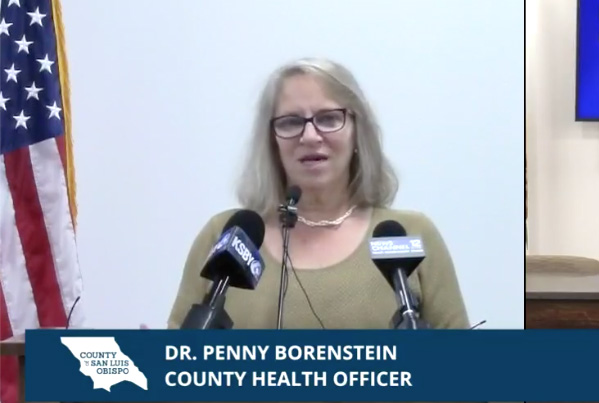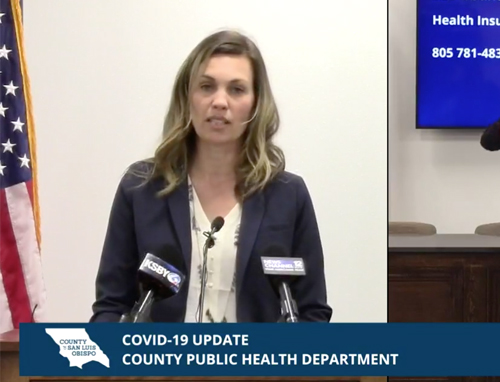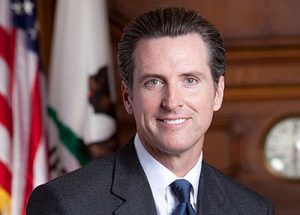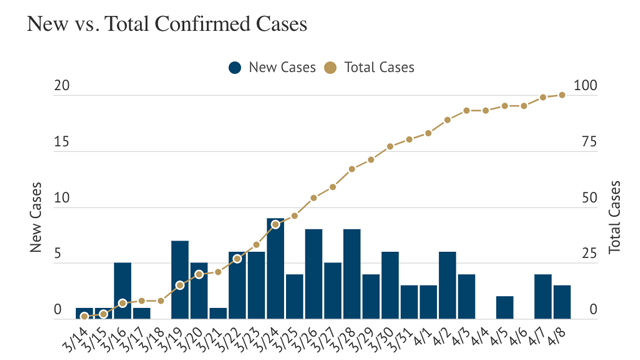COVID-19 Update: SLO County reports two new cases, 104 total cases, 75 recoveries
–On Thursday, April 9, the County of San Luis Obispo updated the community on the COVID-19 pandemic. At this time, 104 local residents have tested positive for the COVID-19 coronavirus. The county reports that 75 local patients have now recovered from the virus, three are hospitalized, two of those cases in intensive care units, and 25 are at home.
More than half of the cases in SLO County are in the North County area. There are 59 cases in North San Luis Obispo County, 29 cases in Paso Robles, 20 cases in Atascadero, and six cases in Templeton.
By Thursday afternoon, there were at least 19,131 cases and 507 deaths in the State of California and 456,828 cases and 16,294 deaths in the United States, according to Johns Hopkins University.

Dr. Penny Borenstein.
SLO County is flattening the curve
“We are seeing a flattening of our curve,” said SLO County Health Officer Dr. Penny Borenstein at a county press conference on Wednesday afternoon. The goal of the Shelter at Home order is to slow the spread of the disease so that county medical services can be prepared to handle new cases. It appears to be working, she said. “We’re doing the hard work now so we can get back to normal.”
There are still reports of pockets of teenagers and others ignoring the social distancing guidelines, but it seems to be working overall, she said. Even if while out on a run with a friend, stay on the opposite side of the street, keep your distance, she said. “Don’t gather in groups.”
Borenstein said the county’s number of cases is so limited that modeling the peak of cases is difficult. “It will come sooner, rather than later,” she said. But could not say if it will be in the next week or two, as California officials expect for the state.
County Administrative Officer Wade Horton announced that the recreation areas at Santa Margarita Lake and Lopez Lake will limit the number of entries this weekend by half.
Distribution of COVID-19 cases in San Luis Obispo County
- Paso Robles reported COVID-19 cases: 29
- Atascadero reported COVID-19 cases: 20
- Arroyo Grande reported COVID-19 cases: 14
- City of San Luis Obispo reported COVID-19 cases: 8
- Morro Bay reported COVID-19 cases: 6
- Templeton reported COVID-19 cases: 6
- Nipomo reported COVID-19 cases: 6
- Other San Luis Obispo County reported COVID-19 cases: 15
Ages of COVID-19 cases in San Luis Obispo County
- Age 0-17 years old – 4
- Age 18-49 years old – 40
- Age 50 – 64 years – 30
- Age 65 and older – 30
Cases of COVID-19 by status in San Luis Obispo County
- At home – 25
- Hospitalized – 3, 2 in ICU
- Recovered – 75
- Deaths – 1
Source of transmission of COVID-19 cases in San Luis Obispo County
- Travel related transmission – 35
- Known person-to-person transmission – 38
- Unknown community-acquired transmission – 29
- Unknown – 2
Number of people tested for COVID-19 in San Luis Obispo County
As of Thursday, the county reports conducting 617 COVID-19 tests. An unknown number of residents have been tested by private labs, the county reports. Private labs doing testing include WestPac Labs, Quest Diagnostics, Pacific Diagnostic Laboratories, LabCorp, VRDL.

Melissa James, CEO of Reach, speaking Thursday afternoon at a county press conference.
Local leaders begin Central Coast Economic Relief Efforts
Communities and households across the Central Coast are facing severe economic hardships as we try to overcome this COVID-19 crisis, and economic relief is on the way.
Local public and private leaders from both San Luis Obispo and Santa Barbara counties have come together as an informal coalition to provide economic relief. Resources as a result of this work can be found at www.RecoverCentralCoast.org.
“Local employers have had to furlough or lay off workers, and residents are struggling to make ends meet,” said Wade Horton, County of San Luis Obispo’s Administrative Officer and Emergency Services Director. “But we are resilient, and we will get through these difficult economic challenges together.”
The County of San Luis Obispo and REACH, formerly The Hourglass Project, are leading a regional economic relief effort in partnership with cities, chambers, and community partners. RecoverCentralCoast.org is the first step the coalition is taking in working together to bring economic relief and recovery to the region. The website, which helps centralize and simplify access to economic relief resources region-wide, is being developed by local governments, Chambers of Commerce, Visit SLO CAL, Economic Vitality Corporation, higher education, local Workforce Development Boards, and local businesses.
“We are one region, and we need to have one united voice, one coordinated response to the significant challenges facing the lives and livelihood of the people of the Central Coast,” said REACH CEO Melissa James. “The first of many actions of this coalition is to bring access to economic relief resources all in one place”
RecoverCentralCoast.org is a dynamic tool being developed by a network of public and private partners. It will make available the most relevant information and resources for our local employers and workforce and currently includes tax relief resources, information about State and Federal stimulus funding, workforce training resources and local job opportunities. With new developments every day, this team will continuously monitor, evaluate and streamline resources to make them available in a central location.
Recent SLO County COVID-19 coronavirus updates
- Virtual COVID-19 screening available on Tenet Health website
- City surveying residents and businesses about COVID-19 impacts
- County parks enact new restrictions to limit spread of COVID-19
- SLO County Alternative Care Site at Cal Poly set to open today
- Local testing capacity increased – Get tested and limit spread of disease
- Paso Robles City Council meets virtually to discuss ongoing COVID-19 crisis
- City of Paso Robles surveying residents about COVID-19 impacts
- Local businesses creates ‘Paso pizza night’ photo contest
- New rules to lower jail population, suspend evictions and foreclosures
- COVID-19: Broader symptoms released by county health department

Gov. Gavin Newsom
Governor announces additional unemployment benefits for workers impacted by COVID-19
SACRAMENTO – Governor Gavin Newsom today announced that starting this Sunday, California workers who are receiving unemployment benefits will begin receiving an extra $600 on top of their weekly amount, as part of the new Pandemic Additional Compensation (PAC) initiated by the CARES Act. This comes as record numbers of unemployment claims are being filed on a weekly basis in the state.
This is an important benefit that will help individual Californians and our small businesses, especially those that are struggling economically as a result of COVID-19.
“Many Californians are feeling the effects of this pandemic, and this added benefit is very important to our workers so they have needed resources during this difficult time,” said Governor Newsom.
In the last four weeks, California has processed about 2.3 million unemployment insurance claims, which is more than the total number of claims filed in 2019. Just for the week ending on Saturday, April 4, 2020, the California Employment Development Department (EDD) processed 925,450 claims, which is a 2,418% increase over the same week last year.
Additionally, the EDD paid a total of nearly $684.3 million in unemployment benefits to Californians in need in the last four weeks, supporting families and their local economies.
For more information on how to apply for unemployment insurance benefits and what claimants need to know about these new $600 additional payments, visit the EDD website.
Governor announces program to provide health care workers with hotel rooms
SACRAMENTO – Governor Gavin Newsom on Thursday announced a new program to provide doctors, nurses and other critical front-line health care workers access to no-cost or low-cost hotel rooms.
The program will prioritize health care workers who come in direct contact with or are suspected of having direct contact with COVID-19 patients, or who test positive for COVID-19 but do not require hospitalization. By providing hotel rooms in close proximity to medical facilities, health care workers can avoid potentially spreading the virus once leaving their shift by selecting to stay in one of the pre-identified hotels across the state.
“California is fighting to protect those who are protecting us,” said Governor Newsom. “Health care workers are the heroes of this moment. As we ramp up the workforce to meet the demand we are also stepping up to help keep our workers’ families safe by providing hotels as temporary housing options.”
Starting April 10, California Health Corps workers will be able to make reservations through the Department of General Services (DGS) CalTravelStore.
The state has already identified 150 hotels that have opted in to provide discounted rates, and more hotels are encouraged to sign up. Hotels interested in participating in offering discounted rooms to health care workers may email covid19lodging@dgs.ca.gov.
DGS is prioritizing bringing hotels on line that are located in counties with high population density or have high numbers of COVID-19 positive test results, including: Los Angeles, Santa Clara, Riverside, San Bernardino, Orange, Alameda, Contra Costa, San Francisco, San Diego and Fresno. This program is being funded in part through FEMA’s disaster relief funds and is also available for local governments to offer to their health care workforce.
Additionally, Governor Newsom announced a partnership with United Airlines, which will provide free, round-trip flights for volunteer medical professionals from across California and the country who join the state’s health care workforce. The airline will connect essential workers and supplies to the areas where they are needed most during the COVID-19 pandemic with daily flights.
The Administration is also working with other major airlines, including Southwest, Alaska Airlines, and Delta, to offer similar services to the health care workforce.
“It is very encouraging to see our industry leaders step up and lend a hand in this effort to help us meet this moment, and support our health care workers to make sure they have resources to get to where they are needed,” said Governor Newsom.
The Governor recently launched the California Health Corps, an initiative to expand California’s health care workforce and recruit health care professionals to address the COVID-19 surge.
Health care professionals with an active license, public health professionals, medical retirees, medical and nursing students, or members of medical disaster response teams in California are all encouraged to join. So far, 86,516 have signed up through healthcorps.ca.gov.
Governor issues order to help state procure medical supplies
SACRAMENTO – Governor Gavin Newsom today signed an executive order to help the state procure necessary medical supplies to fight COVID-19.
A copy of the Governor’s executive order can be found here.
Governor signs order to expand support for vulnerable populations
SACRAMENTO – Today, Governor Gavin Newsom signed an executive order that provides additional support for older adults and vulnerable young children.
The order will allow for a 60-day waiver for In-Home Supportive Services (IHSS) program caseworkers to continue their work and be able to care for older adults, as well as individuals with disabilities.
A copy of the Governor’s executive order can be found here.
CDC recommends wearing of cloth face coverings, masks
“We now know from recent studies that a significant portion of individuals with coronavirus lack symptoms (“asymptomatic”) and that even those who eventually develop symptoms (“pre-symptomatic”) can transmit the virus to others before showing symptoms,” the US Centers for Disease Control said in a statement over the weekend.
This means that the virus can spread between people interacting in close proximity—for example, speaking, coughing, or sneezing—even if those people are not exhibiting symptoms. In light of this new evidence, CDC recommends wearing cloth face coverings in public settings where other social distancing measures are difficult to maintain (e.g., grocery stores and pharmacies) especially in areas of significant community-based transmission.
It is critical to emphasize that maintaining 6-feet social distancing remains important to slowing the spread of the virus. CDC is additionally advising the use of simple cloth face coverings to slow the spread of the virus and help people who may have the virus and do not know it from transmitting it to others. Cloth face coverings fashioned from household items or made at home from common materials at low cost can be used as an additional, voluntary public health measure.
The cloth face coverings recommended are not surgical masks or N-95 respirators. Those are critical supplies that must continue to be reserved for healthcare workers and other medical first responders, as recommended by current CDC guidance.
This recommendation complements and does not replace the President’s Coronavirus Guidelines for America, 30 Days to Slow the Spreadexternal icon, which remains the cornerstone of our national effort to slow the spread of the coronavirus. CDC will make additional recommendations as the evidence regarding appropriate public health measures continues to develop.
See related: Let’s all do our part and cover our mouths and noses in public
What is the cause of COVID-19 transmission?
–Transmission of the COVID-19 virus appears to be caused by close and prolonged contact, Borenstein said. The greater the illness has affected someone, the more likely they are to transmit it to other people, she said. Asymptomatic transmission, if occurring at all, is a minor proportion of infections, she said. Airborne infection appears to be limited to someone infected who coughs or sneezes and vapor droplets may linger for a short period of time. But neither asymptomatic transmission nor airborne transmission appear to be a dominant means of transmission, she said. The virus does tend to transfer well with human contacts, like shaking hands, and linger on hard surfaces, studies have shown.
How people can protect themselves
Every person has a role to play. Protecting yourself and your family comes down to common sense:
- Staying home except for essential activities – “Shelter at home“
- Washing hands with soap and water for a minimum of 20 seconds.
- Avoiding touching eyes, nose or mouth with unwashed hands.
- Cover a cough or sneeze with your sleeve, or disposable tissue. Wash your hands afterward.
- Avoiding close contact with people who are sick.
- Staying away from work, school or other people if you become sick with respiratory symptoms like fever and cough.
- Practicing social distancing.
- Following guidance from public health officials.
What to do if you think you’re sick
Call ahead: If you are experiencing symptoms of COVID-19 (fever, cough or shortness of breath) and may have had contact with a person with COVID-19, or recently traveled to countries with apparent community spread, call your health care provider before seeking medical care so that appropriate precautions can be taken.
San Luis Obispo County’s urgent communicable disease line is (805) 781-4553.
- Follow all local COVID-19 coronavirus news updates
- San Luis Obispo County COVID-19 website – readyslo.org
Comments
The news staff of the Paso Robles Daily News wrote or edited this story from local contributors and press releases. The news staff can be reached at info@pasoroblesdailynews.com.





















